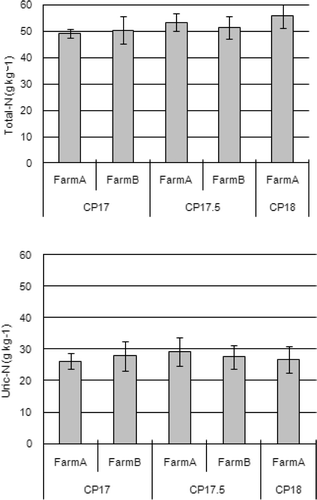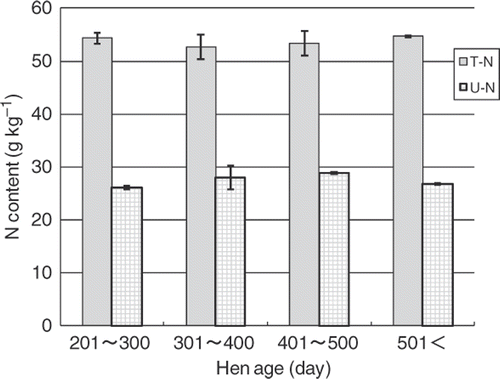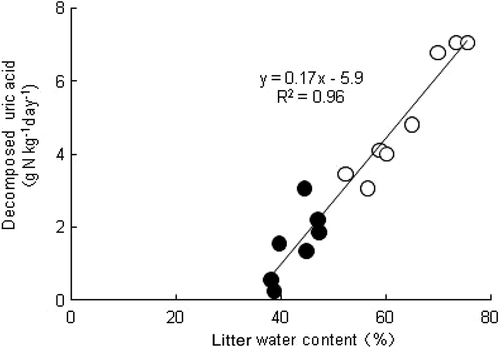Abstract
Microbial mineralization of urea and uric acid in poultry litter can lead to loss of nitrogen (N) content and its value as a fertilizer. To minimize the loss of N in the composting processes, controlling the water content in litters is a key to reduce the mineralization processes of N compounds. The N content of litter may be influenced by diets, hen age and the type of poultry houses used. The objectives of the present study were i) to determine the relationship between the water content and the decomposition rate of uric acid in poultry litter and ii) to investigate the effect of hen age and crude protein (CP) percentages in diets on the N content of poultry litter. A layer feeding trial was conducted in two poultry farms with windowless and open-floor houses. An incubation study of poultry litter was performed under different levels of water content. Our study found that the diet CP percentage (16.5–18%) and the growth stage of laying hens did not have a significant effect on the amount of total N (52–56 g kg−1) and uric acid-N (26–31g kg−1) in fresh litters. At the 7th day of litter incubation study, the concentration of uric acid-N was 22 g kg−1 in litters with a water content of 35%, whereas it further decreased to less than 1.3 g kg−1 in litters with a water content of 55% and higher levels. The decomposition rate of uric acid-N in litter was 0.3–3.1g kg−1 day−1 in the windowless house and 3.1–7.1g kg−1 day−1 in the open-floor house. Decomposition of uric acid in litters was positively correlated to the litter moisture content that is controlled to be lower in windowless houses (40–50%) than in open-floor houses (55–80%) during the composting period. Our study suggests that the use of windowless houses for layer chicken production is effective for producing poultry manure with a high N content.
Introduction
With the increased scale of livestock farming, the management of livestock waste has become a serious problem in Japan. The Japanese government encourages the production of compost from livestock manure and the land application of compost (Ikumo Citation2005). However, due to the inconvenience of handling and transportation, manure has not been widely used as an alternative to chemical fertilizers. Over the past 20 years, there has been an increasing effort to improve the use of manure as a fertilizer source. Animal manures are valuable sources of plant nutrients and organic matter, which can improve soil physical and chemical conditions (Muñoz et al. Citation2004). Poultry manure contains a greater amount of nitrogen than other types of animal manure and it can be an alternative to chemical fertilizers.
Poultry manure contains 40–70% N as a form of uric acid that is decomposed to ammonia gas (NH3) via microbially mediated mineralization, as expressed in the following equations:
Minimizing the loss of NH3 through the manure composting process is also important in poultry production and environmental issues. In a poultry house, keeping the NH3 concentration below 25 mg L−1 is recommended to maintain bird health (Dawkins et al. Citation2004; Ritz et al. Citation2004). Ammonia gas can be a major source of air pollution and can also serve as a component of nuisance odors from poultry facilities (Williams Citation1995; Wheeler et al. Citation2006). To reduce the N loss through composting processes, Murakami (Citation2011) studied a closed composting system connected to a windowless poultry house for poultry litter composting. They found that the N loss in litter during the composting system was reduced compared to an open-house composting system. The reduced N loss in the windowless house results from the rapid composting process that is complete around 7 days at 70°C. The composting process in the windowless house minimized the decomposition rate of uric acid in litters, and compounds harmful for plant growth, such as allelochemicals, and pathogenic microorganisms can be eliminated in litters exposed to the high temperature for several days.
The N content in fresh layer litters is little affected by the diet, but is affected by conditions during composting processes. Nakatani et al. (Citation2002) reported that the N content in fresh layer litters is about 60 g kg−1, regardless of dietary crude protein (CP) levels. In the closed composting system (i.e., the windowless house), however, it is unknown how N content in poultry manure is affected by feeds. Murakami et al. (Citation2007) found that the amount of total N and uric acid is strongly dependent on the type of composting system, which is in agreement with findings elsewhere (Nakatani et al. Citation2002). Since the water content of poultry manure was different among the different composting systems, it is hypothesized that the water content in litter affects the rate of decomposition of uric acid and thus the amount of total and available N. To produce poultry manure with a high N content, it is important to understand the behavior of uric acid in relation to the water content through the composting processes. The objectives of the present study were i) to determine the relationship between the water content and the decomposition rate of uric acid in poultry litter and ii) to investigate the effect of hen age and CP content in diets on the N content of poultry litter. We investigated the N content in laying chicken litters collected from different types of poultry houses (i.e., windowless and open-floor houses).
Materials and Methods
Feeding trial and litter N content
Layer feeding trials were conducted in two layer chicken farms in Mie Prefecture, Japan. Layer chickens (Dekalb White) in both farms were fed by the same commercial feed containing three different levels of CP (16.5%, 17%, and 18%). Layer hens were at four different growth stages (201–300, 301–400, 401–500 and >500 days). Ten litter samples (a mixture of manure, bedding material, and feathers) were randomly collected from windowless and open-floor poultry houses at the 5th day since the feed trial started. The litter samples were immediately freeze-dried until analysis. The samples were analyzed for the total N and uric acid-N in accordance with methods used elsewhere (Murakami et al. Citation2007).
Incubation study of poultry litter
To determine the effect of water content in poultry litter on uric acid content, an incubation study was performed under different levels of water content. The randomly collected litter samples from a windowless poultry house at day 5 were homogenized by a food processor. The samples were placed in a 100 mL polyethylene container to a thickness of 10 mm from the bottom. Sterilized water was added to each container to adjust the water content to 35%, 45%, 55%, 65%, 75%, and 80%. Each container was covered with a plastic sheet with holes to allow gaseous exchange to prevent anaerobic conditions. The incubation was performed for 7 days at 25°C in a chamber. The experiment was conducted with three replicates (n = 3). The amount of water evaporated from each container was maintained on a weight basis by additions of sterilized water at 2-day intervals. The aliquot of samples was collected periodically from each container and analyzed for uric acid-N by the method used elsewhere (Murakami et al. Citation2007).
Results and Discussion
Effect of diet CP and hen age on N contents
The CP percentage in diets did not have a significant effect on the amount of total N (52–56g kg−1) and uric acid-N (26–31g kg−1) in fresh litter collected at day 5 (p > 0.05; ). There were no differences in the concentrations of total N and uric acid-N among the poultry farms and hens of various ages (p > 0.05, and ). Nakatani and Ichikawa (Citation2004) reported that the total N content of litter from Dekalb White did not increase significantly with CP levels in diets. Tokumaru and Okazaki (Citation2008) found that the total N in litters (59–65g kg−1) was not significantly different among the growth stages from 144 to 448 days. These findings corresponded to what we found in the present study. We therefore conclude that the concentrations of total N and uric acid-N in fresh litters are not dependent on the CP percentage (16.5–18%) in diets and the hen age (over 201 days).
Litter water content and uric acid decomposition
The concentrations of uric acid-N in litters treated with different water contents were expressed as a function of incubation period (). The rate of decomposition of uric acid increased with the water content. At the 7th day of litter incubation, the concentration of uric acid-N was 22 g kg−1 in litters with a moisture content of 35% whereas it further decreased to less than 1.3 g kg−1 in litters with a moisture content of 55% and above levels. The concentration of uric acid-N in litters decreased rapidly within the first 2 days in the litter treated with a water content of 45% and above. The reduction rate of uric acid-N in the first 2 days was over 90% in litter treated with a water content of 65% and above. In general, poultry litter with a lower water content has less odor and is readily handled for composting processes. The water content of litters depends primarily on the structure of the poultry house. Izumo (Citation1993) reported that the water content of litters collected from a windowless house was 67% on average, which was lower than those collected from an open-floor house (74%). Potrikus and Breznak (Citation1981) reported that the reduction of uric acid in a litter composting process was likely attributed to growth of anaerobic bacteria that consume uric acid as an N source. Litters with low levels of water content reduced the decomposition rate of uric acid through the composting process. In general, the windowless house is equipped with a pre-drying system for litters, and therefore the water content of litter can be effectively reduced. It is plausible that the reduction of uric acid decomposition may result from inhibition of microbial activities to produce uricase and urease in litters. The decomposition of uric acid to ammonia requires the activity of these major bacterial enzymes with one of the major limiting factors being the conversion of urea to ammonia by microbial urease activity (Rothrock et al. Citation2008).
Figure 3. Uric acid nitrogen (N) content of litters with different water contents as a function of incubation period. Error bars represent standard deviations of mean.

shows the amount of decomposed uric acid as a function of water content in litters collected from the windowless and open-floor houses. The decomposition rate of uric acid-N in litters was 0.3–3.1 g kg−1 day−1 in the windowless house and 3.1–7.1 g kg−1 day−1 in the open-floor house. The moisture content of litters was lower in the windowless house (40–50%) than in the open-floor house (55–80%). The daily amount of decomposed uric acid was well regressed by the water content of litters with a simple linear equation (R 2 = 0.96). This result obtained from the composting system indicates that the decomposition of uric acid is strongly dependent on the water content of litter, which is in agreement with the findings of the incubation study (). Because the windowless house was equipped with a dehydrator system, the water content of litter stayed low throughout the composting period compared to that in the open-floor house. Several studies have shown that the N loss rate via NH3 volatilization increases with an increase of moisture content (e.g., Bishop and Godfrey Citation1983). Thus, the significant reduction of uric acid decomposition in the windowless house compared to the open-floor house was attributed to the short composting period (5 days) and a low water content of litter throughout the composting period.
CONCLUSIONS
Our study found that the CP percentage in diets and the growth stage of layer hens did not have a significant effect on the amount of total N (52–56 g kg−1) and uric acid-N (26–31g kg−1) in fresh litters. The daily decomposition rate of uric acid in litters increased with the retention time, resulting in the reduction of total N content and in odor via ammonia gas emissions. Decomposition of uric acid in litters was closely related to the water content. It should therefore be noted that maintaining the water content in litters below 35% may be effective in the composting process to produce poultry manure with a high N content. Windowless houses enabled the litter water content to be less than 50% and shortened the time required for composting to within 5 days. These features of windowless houses resulted in the production of poultry manure with a high N content. Therefore, our study suggests that the use of windowless houses is required to produce poultry manure with high total- and uric acid-N contents. It is important to note that the composted product using the windowless-house system in a short compositing period can be safe to use as a manure fertilizer since the product had no odor and was confirmed not to have detrimental effects on plant growth.
Acknowledgments
The authors would like to thank Mr. H. Kondo (CEO of Suzuka Poultry Co. Inc., Suzuka, Mie) for his support and comments on the experiment. This study was supported in part by The Environment Research and Technology Development Fund (K112020) provided from The Ministry of the Environment, Japan.
References
- Bishop , PL and Godfrey , C . 1983 . Nitrogen variations during sludge composting . Biocycle , 24 : 34 – 39 .
- Dawkins , MS , Donnelly , CA and Jones , TA . 2004 . Chicken welfare is influenced more by housing conditions than by stocking density . Nature , 427 : 342 – 344 .
- Izumo , H . 1993 . The amount of poultry litter from a windowless house and open-floor house . Yokeinotomo , 376 : 29 – 34 . (in Japanese)
- Ikumo , H . 2005 . Estimation of potential supply of livestock waste compost to replace chemical fertilizer use in Japan based on 2000 census of agriculture . Jpn. Agr. Res. Quart. , 39 : 83 – 89 .
- Muñoz , GR , Kelling , KA , Powell , JM and Speth , PE . 2004 . Comparison of estimates of first-year dairy manure nitrogen availability or recovery using nitrogen-15 and other techniques . J. Environ. Qual. , 33 : 719 – 727 .
- Murakami , K . 2011 . Modern technologies in animal manure utilization. 5. Development and use of chicken manure fertilizer . Jpn. J. Soil Sci. Plant Nutr. , 82 : 76 – 81 . (in Japanese)
- Murakami , K , Kosaka , S and Hara , M . 2007 . The rapid estimation of available nitrogen in chicken manure compost by determination of uric acid . Jpn. J. Soil Sci. Plant Nutr. , 78 : 85 – 87 . (in Japanese)
- Nakatani , H and Ichikawa , A . 2004 . An in vitro procedure for offensive odor from poultry manure: Standardization of ammonia emission procedure . Res. Bull. Aichi Agric. Res. Ctr. , 36 : 111 – 115 . (in Japanese with English abstract)
- Nakatani , H , Ichikawa , A and Ito , H . 2002 . Effect of composting period and season on nitrogen mineralization in poultry manure . Res. Bull. Aichi Agric. Res. Ctr. , 34 : 239 – 243 . (in Japanese with English abstract)
- Potrikus , C and Breznak , JA . 1981 . Gut bacteria recycle uric acid nitrogen in termites: strategy for nutrient conservation . Proc. Natl. Acad. Sci. U.S.A. , 78 : 4601 – 4605 .
- Ritz , CW , Fairchild , BD and Lacy , MP . 2004 . Implications of ammonia production and emissions from commercial poultry facilities: A review . J. Appl. Poult. Res , 13 : 684 – 692 .
- Rothrock Jr , MJ , Cook , KL , Lovahn , N , Warren , JG and Sistani , KR . 2008 . Development of a quantitative real-time PCR assay to target a novel group of ammonia producing bacteria found in poultry litter . Poult. Sci. , 87 : 1058 – 1067 .
- Rothrock Jr , MJ , Cook , KL , Warren , JG , Eiteman , MA and Sistani , K . 2010 . Microbial mineralization of organic nitrogen forms in poultry litters . J. Environ. Qual , 39 : 1848 – 1857 .
- Tokumaru , Y and Okazaki , Y . 2008 . Reduction of amount of excrement of laying hens by feeding of expander processing fodder . Res. Bull. Chiba Livestock. Res. Ctr , 8 : 23 – 27 . (in Japanese)
- Wheeler , EF , Casey , KD , Gates , RS , Xin , H , Zajaczkowski , JS , Topper , PA , Liang , Y and Pescatore , AJ . 2006 . Ammonia emissions from twelve U.S . broiler chicken houses. Trans. ASAE , 49 : 1495 – 1512 .
- Williams , PEV . 1995 . Animal production and European pollution problems . Anim. Feed Sci. Technol , 53 : 135 – 144 .


